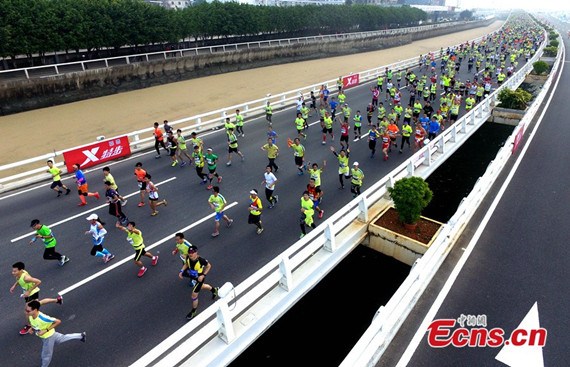
Runners participated in the 2016 Xiamen International Marathon on January 2, 2016. (CNS photo/Wang Dongming)
A survey from Nielsen showed Chinese marathon runners spend an average of 3,601 yuan ($575) on the sport, with more experienced runners tending to spend more to upgrade their performance.
As the marathon mania sweeps across China, more business opportunities are looming.
Nielsen survey shows that core runners spend an average of 4,594 yuan, far more than 2,333 yuan of potential runners.
Ordinary runners spend the most on purchasing basic running sportswear like clothes, shoes, socks and pants, but veteran runners are more tech-savvy and spend the most on high-end devices and professional equipment, such as sports watch, tight jackets and bottles. Eighty-one percent of them use smart phones, 91 percent using smart watches, and 57 percent use electronic wristband devices to log their movement data.
Apart from splurging on sportswear and equipment, runners also spend a lot on travel to different places to compete with other athletes, in addition to expenditure such as entry fees, transportation and accommodation.
Nielsen's data shows that excluding transportation fees, spending of veteran runners hits 3,746 yuan. They traveled an average of 3.7 times a year to join races and spent 6,935 yuan on expenses. Ninety percent of veteran runners say they had the experience of taking part into competitions away from home, with 9 percent travelling overseas.
"The growing number of marathon runners nationwide is due to the country's economic development and rapid expansion of a middle class that is more than ever keen on staying healthy and fit," says Lynn Zhang, vice-president of Nielsen China.
The Nielsen report shows that a large proportion of this expanding group of marathoners is from the country's exploding middle class, young and well-off.
As for the distribution of runners, it reveals that people living in the country's affluent north, east and south regions are more engaged in the sport. People in highly developed mega cities like Beijing and Shanghai have the largest number of runners, which accounts for 17.1 percent and 11.6 percent respectively. People in the less developed west and central China have the lowest participation of only 9.5 percent and 5.4 percent.
When it comes to people's participation rate, the report says those with higher educational levels, higher professional positions and more assets are more likely to run. Twenty-four percent of core runners, referring to people who run at least twice a week in no less than three months, and complete a full marathon over the past three years, have education at Master's level or above. Thirty-six percent of core marathoners are in the middle and senior management positions. Fifty-four percent of core runners own cars and 42 percent of them are bank VIPs.
As the sport gains momentum, host cities try to take advantage of organizing marathons to boost fitness while simultaneously promoting their city's image. Eighty-eight percent of core runners say they have a more positive impression of the host city after participating in a race.
Marathons also mean increased opportunities for businesses. Accompanying the exploding number of marathon runners are business opportunities and benefits that are yet to be fully tapped in China. Its popularity has attracted the attention of companies that want to promote their brands' image and appeal to consumers.
"It is believed sponsorship deals will bring sponsors more publicity and closer contact with clients," says Lynn Zhang.
According to the survey, about 60 percent respondents say they were left with a better impression of the sponsor brand; 68 percent said the sponsor brand has a greater appeal to them than before, and 70 percent said they are more likely to buy the sponsor's' products.
Although the majority of sponsors are sports apparel and automobile manufacturers, the marathon fad has attracted catering and jewelry brands as well. However, they are less impressive to runners compared to traditional sponsors.


















































